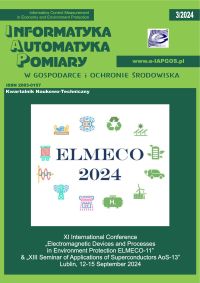ZALEŻNOŚĆ POMIĘDZY LICZBĄ RUND ORAZ ILOŚCIĄ ZAIMPLEMENTOWANYCH WĘZŁÓW W SIECI SENSOROWEJ OPARTEJ NA PROTOKOLE LEACH
Volodymyr Mosorov
w.mosorow@kis.p.lodz.plLodz University of Technology, Institute of Applied Computer Science (Polska)
Sebastian Biedron
Lodz University of Technology, Institute of Applied Computer Science (Polska)
Taras Panskyi
Lodz University of Technology, Institute of Applied Computer Science (Polska)
Abstrakt
W XXI wieku sieci czujników bezprzewodowych zyskały bardzo dużą popularność przede wszystkim ze względu na swoją elastyczność. Szybki rozwój oraz postępy w tej dziedzinie umożliwiły wykorzystanie czujników na bezprecedensową skalę i otworzyły nowe możliwości dla tzw. wszechobecnej komputeryzacji. Całkowita swoboda rozmieszczenie węzłów w sieci bezprzewodowej, jest jedną z największych zalet zastosowania tej technologii. Niestety atut ten jest ten przyczyną największej słabości bezprzewodowych sieci sensorowych tj. zapewnieniem wydajnego, bezprzewodowego źródła zasilania. Jednym ze sposobów sprostowania temu wyzwaniu było opracowanie specjalistycznych protokołów routingu takich jak LEACH, których celem było efektywne wykorzystanie mobilnych źródeł energii umieszczonych w samych węzłach. Badanie przeprowadzone i opisane w tej publikacji ukazuje wpływ liczebności węzłów na życie badanej sieci sensorowej z wykorzystaniem protokołu LEACH.
Słowa kluczowe:
LEACH, sieć sensorowa, sensorBibliografia
Aslam M., Javaid N., Rahim A., Nazir U., Bibi A., Khan Z.A.: Routing Protocols for Wireless Sensor Networks, 2010.
Google Scholar
Barrenetxea G., Ingelrest F., Schaefer G., Vetterli M.: Wireless Sensor Networks for environmental monitoring: the SensorScope experience. Proceedings of the 2008 IEEE International Zurich Seminar on Communications, 2008, 98–101.
Google Scholar
Chunyao F.U., Zhifang Jiang, Wei Wei: An Energy Balanced Algorithm of LEACH Protocol in WSN. IJCSI International Journal of Computer Science Issues, Vol. 10, Issue 1, No 1, 2013, 354–359.
Google Scholar
Ghanem M., Guo Y., Hassard J., Osmond M., Richards M.: Sensor Grids For air Pollution monitoring. Proceedings of the 3rd UK e-Science All Hands Meeting 2004.
Google Scholar
Hart J.K., Martinez K.: Environmental Sensor Networks: a revolution in the earth System Science, Earth-Science Reviews, vol. 78, no. 3–4, 2006, 177–191.
Google Scholar
Howitt I., Gutierrez J.A.: Ieee802.15.4 low rate-wireless personal area network coexistence issues. Proceedings of the Wireless Communications and Networking Conference (WCNC 2003), 2003, 1481–1486.
Google Scholar
Intanagonwiwat C., Govindan R., Estrin D.: Directed Diffusion: a Scalable and robust Communication Paradigm for Sensor Networks. Proceedings of the 6th Annual International Conference on Mobile Computing and Networking (MobiCom 2000), 2000, 56–67.
Google Scholar
Khan Z., Aslam N., Sivakumar S., Phillips W.: Energy-Aware Peering Routing Protocol for Indoor Hospital Body Area Network Communication, Procedia Com-puter Science, Vol. 10, 2012, 188–196.
Google Scholar
Marks M.: A Survey of Multi-Objective Deployment in Wireless Sensor Networks, Journal of Telecommunications and Information technology, 2010.
Google Scholar
Munir S.A., Biao R., Weiwei J., Bin W., Dongliang X.: Mobile Wireless Sensor Network: architecture and enabling technologies for Ubiquitous Computing. Proceedings of the Advanced Information Networking and Applications Workshops (AINAW 2007), 2007, 113–120.
Google Scholar
Pantazis N.A., Nikolidakis S.A., Vergados D.D.: Energy-Efficient Routing Protocols in Wireless Sensor Networks: A Survey. IEEE Communications Surveys & Tutorials, Vol. 15, Issue 2, 2013, 551–591.
Google Scholar
Qing L., Zhu Q., Wang M.: Design of a distributed energy-efficient clustering algorithm for heterogeneous wireless sensor networks. Journal Computer Communications, Vol. 29 Issue 12, 2006, 2230–2237.
Google Scholar
Rasheedl M.B., Javaid N., Javaid A., Khan M.A., Bouk S.H., Khan Z.A., Improving Network Efficiency by Removing Energy Holes in WSNs. J. Basic Appl. Sci. Res. 3(5), 2013, 253–261.
Google Scholar
Wang Xiao-yun, Yang Li-zhen, Chen Ke-fei: SLEACH: Secure Low Energy Adaptive Clustering Hierarchy Protocol for Wireless Sensor Networks. Wuhan University Journal of Natural Sciences, Vol. 10, Issue 1, 2005, 127–131.
Google Scholar
Yadav L., Sunitha Ch.: Low Energy Adaptive Clustering Hierarchy in Wireless Sensor Network (LEACH), (IJCSIT) International Journal of Computer Science and Information Technologies, Vol. 5 (3), 2014, 4661–4664.
Google Scholar
Yick J., Mukherjee B., Ghosal D.: Wireless Sensor Network Survey, Computer Networks, Vol. 52, No. 12, 2008, 2292–2330.
Google Scholar
Autorzy
Volodymyr Mosorovw.mosorow@kis.p.lodz.pl
Lodz University of Technology, Institute of Applied Computer Science Polska
Autorzy
Sebastian BiedronLodz University of Technology, Institute of Applied Computer Science Polska
Autorzy
Taras PanskyiLodz University of Technology, Institute of Applied Computer Science Polska
Statystyki
Abstract views: 255PDF downloads: 62
Licencja

Utwór dostępny jest na licencji Creative Commons Uznanie autorstwa – Na tych samych warunkach 4.0 Miedzynarodowe.
Inne teksty tego samego autora
- Fatma Mbarek, Volodymyr Mosorov, Rafał Wojciechowski, BADANIA REDUKCJI OPÓŹNIEŃ SERWERA WWW , Informatyka, Automatyka, Pomiary w Gospodarce i Ochronie Środowiska: Tom 7 Nr 3 (2017)








